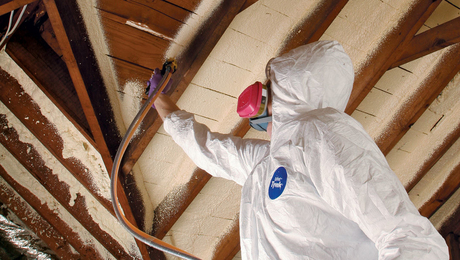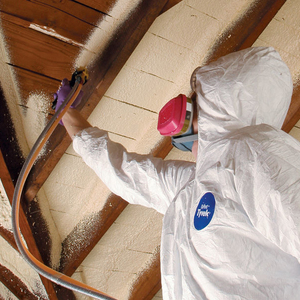What is the best way to insulate 10″ concrete walls
Hello,
I am in the planning stages of building a new home in the South East in a high velocity wind zone area. This is the reason I am using 10” concrete walls (has to with stand 150 MPH wind) and is a material that is readily used and most if not all sub-contractors I will be using are familiar with. This is the home I will be retiring in and want to keep my utility costs down so I want to really insulate this home. The roof will be poured concrete too.
I was thinking of using ICF but they are not readily used here, the inspectors are not familiar with it. I have to have a crew come in from the center of the state if not out of state and it is getting expensive. I also read an article about them and was informed there are other ways of getting the same insulation qualities as ICFs.
How can I insulate this home? I prefer not to use foam on the outside. Can I use 2×4 framing on the inside and use spray foam or and other combination. I will add that the West wall of block homes here in South Florida without exterior insulation get very hot to the touch in the afternoon, I assume this is a substantial heat load.
I am open to suggestions and thank you for your time.



















Replies
I've never seen any details but I believe that there were some problems with ICFs in Katrina in that, while the structure survived fine, much of the foam was torn loose. (This is basically from seeing an ICF structure from a distance in Pass Christian, plus an occasional word here and there -- nothing in print.)
There was a contractor here (southern MN) advertising a poured concrete wall with foam embedded in the middle, so it was solid concrete in and out. However, I don't recall who it was or what the name of their "system" was.
Where are you building in the south east that has experienced concrete wall subs? Why don't you want the insulation on the outside? You're in a cooling climate and very little of the total cooling loss will happen through the walls. it wouldn't be hard at all for you to spend more building and insulating your walls than you'd ever save on energy bills. What are you doing about your roof where the huge energy loss takes place?
I plan to build in the Miami area and I have had no trouble finding subs to work with concrete. You are right about the heat loss. I read a report last night on energy loss and most of it is through the roof. I thinking of using a poured concrete flat roof with two inches of insulation on top. The interior ceiling will have R-30.
I prefer not to insulate on the exterior and only use stuco because it will be easier to repair hurican damge from debris.
Whay I am builing so srong is to cut down on my insrance costs. I ahve been paying on my homes from $8500 on up and am tired of spending this king of money on insurance. I may not even have insurance on the new place if I buid it like a fort.
I still don't think you'd ever recoup your building costs in energy savings but if you're wanting a highly hurricane resistant house concrete is the way to go. A hip roof is probably better than flat and will save you all kinds of leak problems down the line. I'd spray 6 inches of closed cell poly against the underside of the roof and seal the attic. I'd also take my plans to a local prestressed concrete plant and see if they couldn't do it all with prestressed slabs. There was a guy doing that out in Arizona 25 years or so ago, he even did the interior walls with prestressed panels. Put your wall insulation on the outside anyway, cover with chicken wire and stucco. Any hurricane damage would be easy and cheap to repair and you would have real energy savings.
Most heat 'loss' is not through the roof ... A common myth I think. And that is not why roofs get insulated to a higher value. Most heat loss (conductive) is through windows. Even though windows may comprise only a small percentage of the exterior surface area of a house, the heat 'loss' can be larger than the walls and roofs put together.
I'm curious as to how the roof in particular has a "huge energy loss"?
Well, you;re right. I should'nt have said "heat loss", I should have said heat gain since he's in Florida. And, yes, the largest percentage of heat gain is through the roof. That's why codes call for so much insulation there and so little everywhere else. Here in souht Florida code requires 12" in the attic and 3/4" on the walls.of a CBS house.
Heat gain ... understood. But the largest percentage of heat transfer is NOT the roof. The reason why codes require more in roofs/ceilings is more about economics than the science of heat transfer. It is usually very inexpensive to insulate an attic to e.g. R38 ... relative to e.g. wall insulation. Largest percentage heat transfer routinely is windows. Taking into affect the solar gain in cooling climates, the heat transfer of windows often dwarfs that of all other opaque surfaces combined (depending on orientation and protection from the sun).
The OP's primary motivation was a structurally sound shell. Hopefully, he'll be designing windows to minimize energy use in addition to his concern about how to insulate his super strong structure. Orientation and glazing choices are high priorities there.
The sun hits the roof much more strongly than the rest of the house, especially in lower latitudes and if the roof has a decent overhang. So the sun WILL account for a disproportionate (to its area) amount of the "heat gain" in a cooling environment.
While the sun hits the roof pretty strong ... during the mid day ... the solar gain really isn't high (relatively speaking). In the late hot summer afternoon, the sun hits a west facing window almost perpendicular (where even a large overhang does very little to control that gain) ... and the window allows direct solar MUCH more readily than the opaque surface of a roof. If the roof is standard attic/framed, the solar affect is pretty small. On a flat roof that has decent reflectance/emittance, the affect is also pretty small. Any insulated roof will see a pretty small affect from solar gain (again, relatively speaking).
The sun is much stronger straight down than at an angle. This is why we have summer and winter.
Obviously windows are a big factor, but we're talking about wall/ceiling insulation here, not windows.
Alternatives to ICFs ...
One is to insulate the outside ... make provisions for attaching the 'siding' (whatever it may be) through the insulation into the concrete. Another is to fur the inside w/ framing, insulate and drywall ... or glue rigid and drywall ... or some similar approach.
Another option is to place insulation inside the wall ... this is done using a standard tilt up wall construction and would work well w/ your 10" wall. You pour the first 3-4 inches and while doing so you insert plastic ties (my best description, although I think they are a fiber/carbon composite of sorts... and I forget the brand) or pins that structurally connect the two halves of the wall. After the pour, you impale your rigid insulation (e.g. 2-3" extruded polystyrene) onto the pins which are then exposed 2-3" on the other side. You pour the 2nd half and ... that's it. This leaves you with an exposed concrete finish ... which many may consider an undesireable interior finish (I personally would love it). You can color the concrete, you can seal it, too. You can also create relief designs AND color as you might like. This is all pretty standard stuff, really. An experienced concrete contractor doing commercial work should be able to do this stuff. BTW the plastic pins minimize the heat transfer that would be associated using standard rebar.
I don't know what FL requires for insulation by code, but your minimum values would have to meet any codes they have. Other than that, I don't see your concrete structure having much of an issue with air infiltration. That's a huge killer of R-value. So whether you used closed cell spray foam or foam sheets, I don't think you will see much benefit from anything more than R-19. You could put the insulation on the inside or the outside. That will be up to you and what you want.
I was trying to get the values claimed by ICF construction, They report say they are very high and the houses are very efficient when it comes to engery consumtion. R-19 I can get on the inside which what I think I will do.
Thank you for your reply.
Be cautious with CLAIMED R-values vs. real R-Values. Often ICF mfgs tend to claim the benefit of thermal mass in restating the 'effective R-values' of their product. Thermal mass benefits of R-value are largely BS.
I'm just trying to think this through...
You live in a hot climate, with very intense sun. Concrete acts as a large thermal mass, slowly releasing heat long after the source has been removed.
So with the concrete on the outside and the insulation on the inside, you are living in a large concrete oven that you are working to keep the heat OUT of. All the insulation does is slow down the heat transfer... but it still transfers. It will keep transfering long after the sun goes down.
On the other hand, if you insulate the outside, you are slowing down the transfer of heat to the inside. The thermal mass of the concrete then acts to keep the cooling level inside your house.
Thermal mass works both ways
It changes temperature more slowly.
This means that it both heats and cools slowly.
Yes it will hold heat longer into the evening. It also will stay cooler longer into the morning.
If it is cool enough in the evening to not need an air conditioner, then that argument is plausable - you are just shifting the cooling load, perhaps even to the point where you are only air conditioning in the evening during off peak hours.
But why even do that?
Instead of trying to cool your hot concrete walls and ceiling, why not just prevent them fromheating up in the first place? Use that thermal inertia in YOUR favor instead of using your HVAC to fight against it.
I'm kinda with Jigs on this -- absent some special mechanism to concentrate heating of the concrete (eg, painting it black and focusing the sun on it), and absent some special circumstances such as a limited supply of cooling capacity that makes cooling "storage" valuable, it should be pretty much a wash as to where you put the insulation.
I was thinking more along the lines of Florida's post below - it gets heated and never gets the chance to release the heat back outdoors again, but I can also see the validity of the other way as well.
Anyone have a Building Science link to see who's righter?
Except that in south Florida summers there is no cool evening to cool the walls.